
Chinese resources
This guide is for scholars, researchers, historians, students, genealogists and anyone with an interest in Chinese topics.
About this guide
In this guide you will find information about Chinese people in New Zealand, Chinese New Zealanders, and some prominent non-Chinese New Zealanders who spent time in China.
The topics covered include:
general histories and overviews of Chinese settlement
Chinese people in the gold rush era
history and experiences of Chinese women in New Zealand
histories of Chinese associations in New Zealand
information relating to official documents, such as the poll tax
The Chee Kung Tung (Doris Chung collection)
Use the links on the right-hand side of the page under the heading ‘In this research guide’ to see all the topics and to navigate the information on this page.
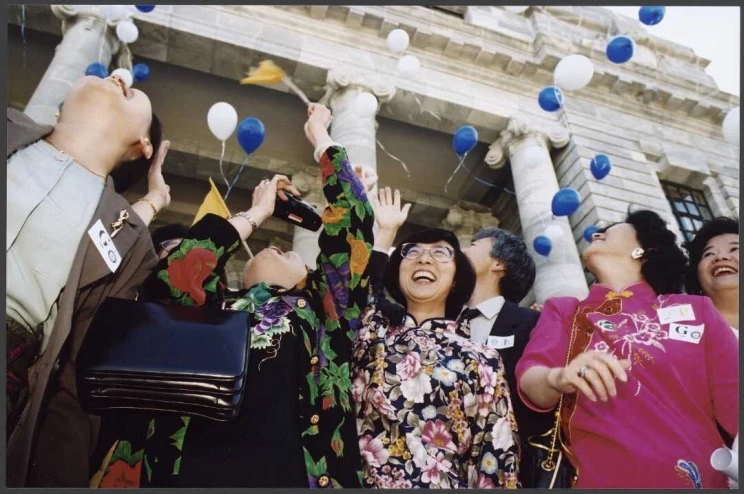
National Member of Parliament Pansy Wong, with her supporters, releasing 130 balloons from Parliament steps, Wellington, to mark 130 years of Chinese settlement in New Zealand. Photograph taken 18 March 1997, by Dominion newspaper staff photographer Dave Hansford, and published by the newspaper on 19 March 1997. Ref: Dom/1997/0319/1/25-F. Alexander Turnbull Library.
Overview of Chinese settlement in New Zealand
There are a number of general histories covering early Chinese settlement in New Zealand in the gold rush era through to settling in other towns and cities, industries and livelihoods, and present day information.
Te Ara New Zealand Encyclopedia's entry on Chinese in New Zealand
Our collections hold published books with an overview of Chinese Settlement in New Zealand. Some examples are:
Dragons on the long white cloud: the making of Chinese New Zealanders / Manying Ip.
North Shore City, N.Z.: Tandem press. 1996.Unfolding history, evolving identity: the Chinese in New Zealand / edited by Manying Ip.
Manying Ip. Auckland, N.Z.: Auckland University Press. 2003.Niu Xi Lan hua qiao she lue / Zhou Yao Xing bian zhu = A brief history of the overseas Chinese in New Zealand /Joe Y. Sing.
Wellington, N.Z.?: Niu Xi Lan Shuang Xing Chu Ban She. 1996. Language: Chinese; English.National Library catalogue — Search results for resources about early Chinese settlement
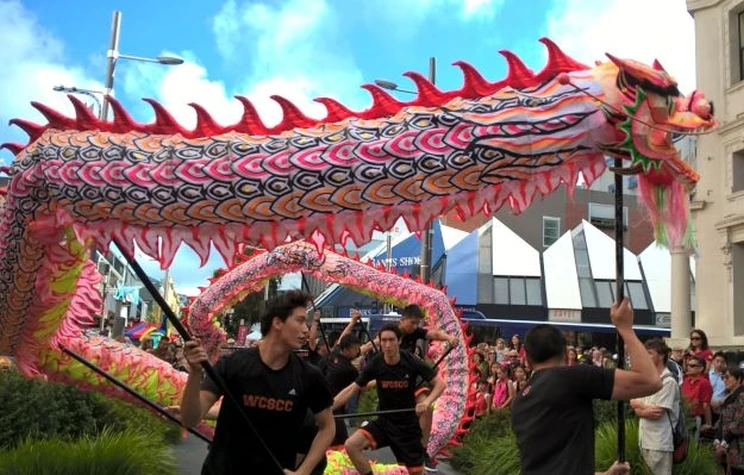
Dragon Dance at Lantern Festival, Lower Cuba Street, Wellington, 2018. Photo: Amalaratna. Used with permission.
Chinese people in the gold rush era
Chinese gold seekers first came to New Zealand's Otago goldfields (the new “Gold Mountain”) in 1866 to escape poverty and famine in south China and to send money back home to their families in China.
Our collections include photographs, books, articles, manuscripts, images and oral histories.
National Library website search — Results for 'chinese gold miners'
Book subjects include the settlement of Cantonese gold seekers, specific settlement towns such as Arrowtown, mixed marriages, attitudes towards Chinese people and Chinese mission work.
National Library catalogue — Search results of books related to 'chinese gold miners'
More comprehensive information about the gold rush era
Author James Ng has written comprehensive books with information on the history of Chinese people in the gold rush era.
How the Cantonese goldseekers and their heirs settled in New Zealand / James Ng; [... edited and indexed by Otago Heritage Books]. Series: Windows on a Chinese past, v. 1. 1993.
Don's 'Roll of Chinese' / James Ng; [... edited and indexed by Otago Heritage Books]. Series: Windows on a Chinese past, v. 4. Dunedin N.Z.: Otago Heritage Books. 1993. Don's 'Roll of Chinese' lists the names of 3,500 Chinese in New Zealand from 1883-1913. Section 1 covers 1883-1896 with names in English. Section 2 covers 1896-1913 and gives names in Cantonese, with details in English. Indexed in English.

Chinese gold miners at Muddy Creek, Waikaia, alongside a cob cottage. Ref: 1/2-019165-F. On the right: Chinese gold miner, Wing Chung, with cradle on the banks of the Clutha River taken ca. January-February 1901. Ref: 1/2-019695-F. Alexander Turnbull Library.
Prominent, early Chinese people in New Zealand
Prominent, early Chinese settlers include Appo Hocton, Choie (Charles) Sew Hoy and Chew Chong.
Appo Hocton
Appo Hocton (1819[23?]-1920) was the first naturalised Chinese immigrant to New Zealand. He arrived in Nelson in 1842 after deserting the ship on which he was a steward and became a property developer, merchant and farmer.
Chew Chong
Chew Chong (1827[44?]–1920) arrived in Otago around 1867 and lived in New Plymouth in 1870. He opened stores in several towns and was an entrepreneur who helped establish the dairy industry in the Taranaki Region.
Choie Sew Hoy
Choie Sew Hoy (1836[8?]-1901) arrived in Otago around 1868. He was a prominent businessman, merchant and entrepreneur whose new gold dredging technology improved the gold mining industry.
Merchant, miner, Mandarin: the life and times of the remarkable Choie Sew Hoy / Jenny Sew Hoy Agnew and Trevor Agnew.
Christchurch, New Zealand: Canterbury University Press. 2020.
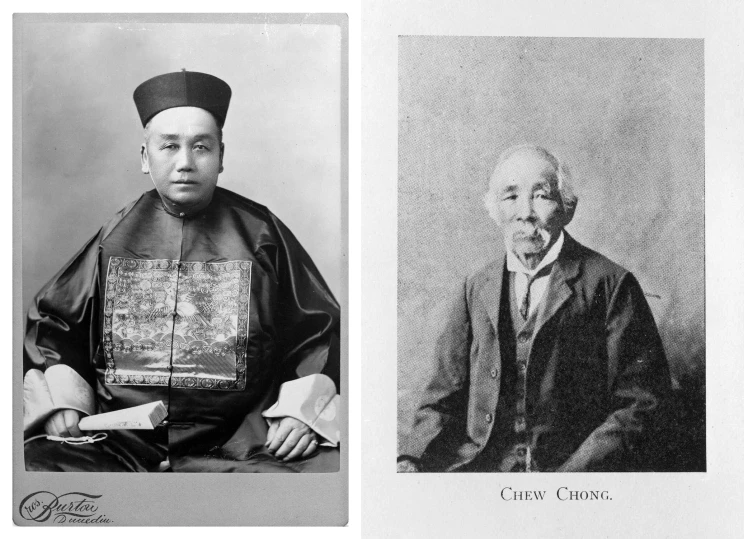
A carte de visite, or cabinet photograph, of Charles Sew Hoy, originally taken by the Burton Brothers circa 1895. Ref: 1/2-037249-F. On the right, Taranaki business man Chew Chong. Ref: 1/2-023954-F. Alexander Turnbull Library.
Early Chinese settlement in cities and towns
After the gold rush era in Otago finished, many Chinese people settled in cities and towns around New Zealand, forming communities. In Wellington, the ‘Chinatown’ was centred around Haining and Frederick Streets in Te Aro. We hold information on specific cities and towns:
Wellington
National Library website search — Results for Haining Street in Wellington
Representing Haining Street: Wellington's Chinatown 1920-1960, by Lynette Shum. Thesis (M.A.)--Victoria University of Wellington, 2007.
Christchurch
Chinese of Christchurch = Ka lai zuo zhi hua qiao / Vanessa Sue ... [et al.]. Christchurch, N.Z.: Sociology Dept., University of Canterbury. c1982.
Taranaki
In the mountain's shadow: a century of Chinese in Taranaki, 1870 to 1970 / Helen Wong = Zai shan de yin ying: yi ge shi ji han ren Taranaki 1870 dao 1970 / Chen Meiying. Helen Wo. Auckland, N.Z.: H. Wong. 2010.
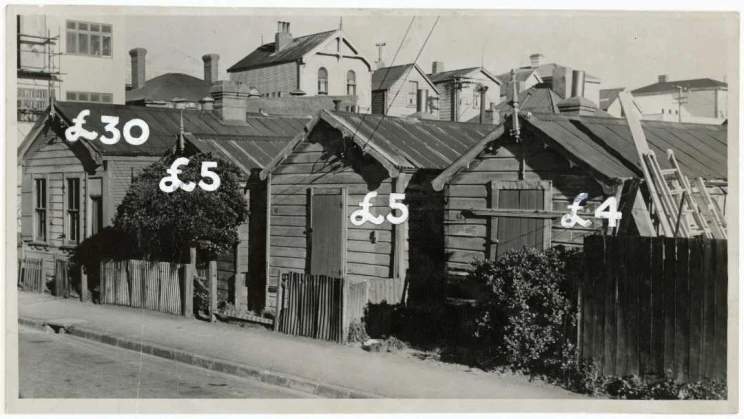
Cottages in Haining Street, Wellington, labelled with 1947 prices. One is listed as selling for 30 pounds, two are selling for five pounds, and one for four pounds. Photograph taken by an unidentified Evening Post staff photographer in 1947. Ref: PAColl-9150-14. Alexander Turnbull Library.
History and experience of Chinese women in New Zealand
The Library holds books and other resources such as manuscripts, oral histories and articles on the history and experience of Chinese women in New Zealand. Some examples include:
Home away from home: life stories of Chinese women in New Zealand / [edited by] Manying Ip. Auckland, N.Z.: New Women's Press. 1990.
Elisabeth Mei-Xing Ngan's speech notes for a 1993 YWCA lecture detailing her experiences as a Chinese woman living in New Zealand and the experiences of women in her family. Ref: MS-Papers-5072
Oral history of Chinese women in New Zealand. Oct 2005 to Apr 2006 - 15 Oct 2005 - 29 Apr 2006. Ref: OHColl-0804. Interviews covering life experiences, aspirations, attitudes and expectations with eight women who came from different counties in China, have lived in New Zealand for over fifty years and who are from the 'old' Chinese community. The ages of those interviewed range between mid 50s to 92 years old. Three women were born in New Zealand, the others migrated to New Zealand between 1939 and 1951. The interviewees are Judy Cheung, Joyce Comfort, Dorothy Gee, Janet Joe, Jean Meng Yee, Mollie Ngan Kee, Aimee Poy and Chung Leen Wong. Access to the collection is unrestricted but individual interviews may be restricted.
Introducing Pansy: our new Minister of Women's Affairs. Apr 2009. Profiles the MP for Botany, who became Minister of Women's Affairs in the 2008 Key Government, talking to her about her values, her Chinese background, and her goals for women in New Zealand. Appeared in 'Her magazine', Apr 2009; n.102:p.30-32.
Farewell Guangdong: Refugee wives and children arrive in Aotearoa New Zealand, 1939-1941. Wellington: Chinese Poll Tax Heritage Trust, 2021.
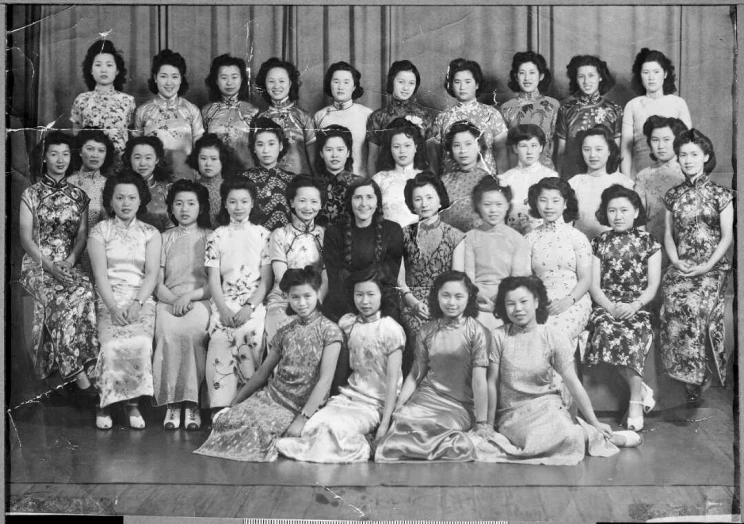
Group portrait of Chinese women with pianist Lili Kraus. Photograph taken 22 February 1947, probably before or after Kraus' concert at the Wellington Town Hall. Ref: 1/2-170582-F. Alexander Turnbull Library.
Industries and occupations involving Chinese people in New Zealand, including market gardens, laundries and fruit shops
After the gold rush era, people set up their own businesses, including market gardens, shops, and laundries.
We hold books with extensive research on the history of Chinese market gardens, fruit shops and laundries. There are also some manuscripts, photographs, oral histories and journal articles related to this topic.
The fruits of our labours: Chinese fruit shops in New Zealand / Ruth Lam, Beverly Lowe, Helen Wong, Michael Wong and Carolyn King. Wellington: Chinese Poll Tax Heritage Trust. 2018.
Sons of the soil: Chinese market gardeners in New Zealand = Huángtǔ zǐsì / Lily Lee and Ruth Lam. Pukekohe N.Z.: Dominion Federation for New Zealand Chinese Commercial Growers. 2012. Note: Sons of the Soil is one of a two-book set on Chinese market gardening in New Zealand. The other book is Success through Adversity: A History of the Dominion Federation of New Zealand Chinese Commercial Growers.
Chinese market gardening in Australia and New Zealand: gardens of prosperity / Joanna Boileau. Palgrave studies in the history of science and technology. Cham, Switzerland: Palgrave Macmillan. 2017. Author resident in New Zealand. Language: English
Starch Work by experts: Chinese laundries in Aotearoa New Zealand / Joanna Boileau. 1953. Wellington, Aotearoa New Zealand: Chinese Poll Tax Heritage Trust. 2019.
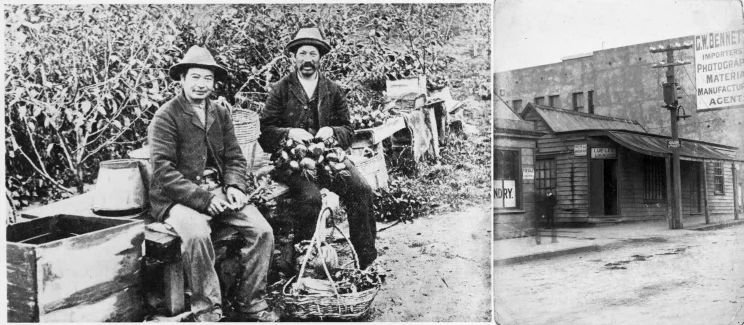
Ah Sam and Joe Quin with vegetables, preparing for the market in Roxburgh, ca. February 1903. Ref: PAColl-7581-96. On the right is a photograph of Quin Street, (later Sturdee Street, and later Victoria Street), Wellington, circa 1903-4, showing the Lue-Lee Laundry building. Ref: PAColl-6348-59. Alexander Turnbull Library.
Chinese associations and communities in New Zealand
Communities, societies and associations often formed according to specific ancestral areas of origination in China. These included the Tung Jung Association of New Zealand, the Poon Fah Association of New Zealand, the New Zealand Seyip Association, the Chee Kung Tong and the Tung Meng Hui.
The New Zealand Chinese Association, the very first Chinese Association of New Zealand was established in 1909 by Consul Huang Roliang to help the Chinese community organise its affairs and to run training courses in Chinese and English.
In September 1934 in response to Consul Qinxuns request that the many Chinese organisations (Chee Kung Tong, the Tung Meng Hui, Tung Jung Association, Poon Fah Society and Seyip Society) existing at that time come together and form one association to reduce friction, avoid clashes and to improve unity and harmony within the New Zealand Chinese community. This Association was named the New Zealand Chinese Association to differentiate it from the original Chinese Association.
Chee Kung Tong: the Hung League in New Zealand. Wellington, N.Z.: Alexander Turnbull Library. 1991? "National Library Gallery, 10 May - 22 June, 1991. Curated by Nigel Murphy and Kirsten Wong"--Foreword.; Title on added t.p.: Zhi Gong Tang: Hong Men Hui zai Niu Xi Lan.; Text in English and Chinese, with chinese text on inverted pages.; Cover title.; Catalogue of an exhibition. Language: English; Chinese.
Turning stone into jade: the history of the New Zealand Chinese Association = Diao shi cheng bi / David Fung. Other Title: Diao shi cheng bi. 2014.
Zengcheng New Zealanders: a history for the 80th anniversary of the Tung Jung Association of NZ Inc / edited by Henry Chan = Niuxilan Zengcheng qiao yi: Niuxilan dong zeng hui guan ba shi zhou nian ji nian / Chen Minxi.
Wellington, N.Z.: Tung Jung Association of New Zealand. 2006.Xin Xi Lan Pan Hua Hui Guan jiu shi zhou nian = Poon Fah Association of NZ 90th Anniversary. Other Title: Cheng li jiu shi zhou nian zhi qing. Contributor: Poon Fah Association of New Zealand. Wellington, N.Z.: Poon Fah Association New Zealand. c2006. Available from: Poon Fah Association (New Zealand), P.O. Box 6333 Marion Square, Wellington 6141, N.Z.
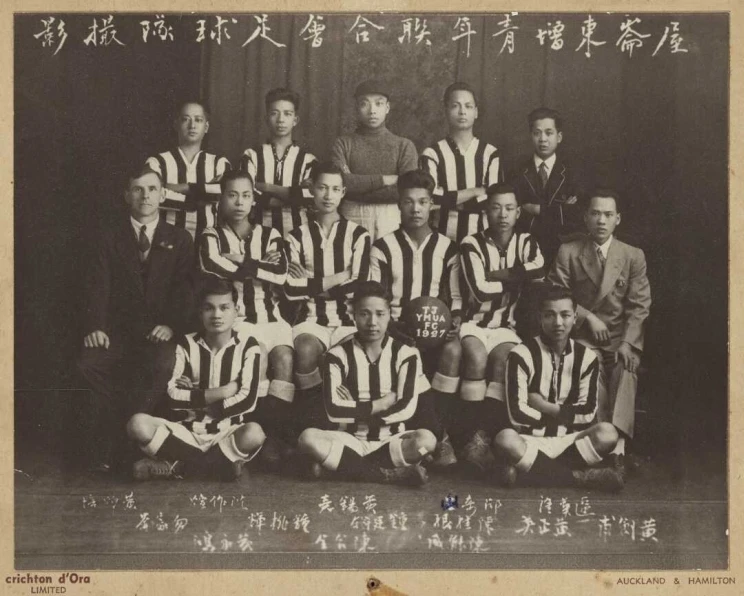
Group portrait of the Tung Jung Young Men's United Association Football Club, taken in 1927. Ref: PAColl-6215-4. Alexander Turnbull Library.
Poll tax and other official documents
The Chinese Immigrants Act of 1881 until 1944 introduced a poll tax of £10 per person and allowed entry to New Zealand of one Chinese passenger per 10 tons of cargo. This was changed in 1896 to one passenger per 200 tons of cargo, but the poll tax was increased to £100. In 2002 the New Zealand government officially apologised for these and other policies.
Immigration Restriction Act 1899
The Immigration Restriction Act 1899 required certificates of registration for non-British citizens leaving New Zealand so that they would be permitted to re-enter New Zealand. These certificates, along with photographs of the person are also held at Archives New Zealand.
We hold only a very few poll tax records or the certificates of registration; the main collections are held at Archives New Zealand.
National Library website search — Results for books about the poll tax and laws relating to Chinese people in New Zealand, including manuscripts, photographs, oral histories and links to newspaper articles.
The poll-tax in New Zealand / a research paper by Nigel Murphy; commissioned by the New Zealand Chinese Association Inc. = Niuxilan ren tou shui / Mailizu ; You Niuxilan Hua lian zong hui wei ren jin xing yan jiu. 2002.
Looking for a better life : the Chinese poll tax certificate records in Wellington = Niu Xi Lan Hai Guan Shu Hui Ling Dun Ban Gong Shi Hua Ren Ren Tou Shul Ji Lu Ce / David Wong Hop. Parallel title: Niu Xi Lan Hai Guan Shu Hui Ling Dun Ban Gong Shi Hua Ren Ren Tou Shul Ji Lu Ce. (Wellington, N.Z.). Creator: David V Wong Hop (David Victor).Contributor: Lisa J. Truttman 1963- researcher. Contents: The Chinese of Wellington. The history of the poll tax. Chinese arrivals in Wellington 1888-1930: alphabetically. Chinese arrivals in Wellington 1888-1930: in years. Female arrivals in Wellington 1888-1930: in years. Chinese from different areas of China who travelled east to the Americas, or south to the Phillipines, Indonesia and Australia. Boats that brought the Chinese to Wellington 1888-1930.
Guide to laws and policies relating to the Chinese in New Zealand 1871-1997 / by Nigel Murphy. Contributor: New Zealand Chinese Association. Wellington, N.Z.: New Zealand Chinese Association. 2008.
Archives New Zealand
Archives New Zealand hold a wealth of information about the Poll Tax and the Chinese experience in New Zealand.
Recent accounts, biographies and published family histories of Chinese New Zealanders
Books of personal accounts, biographies, autobiographies, and some published family histories have been written. These range over several generations either from the ancestral village in China to New Zealand in recent times or from settlement in New Zealand, to more recent accounts.
Being Chinese: a New Zealander's story / Helene Wong.
Wellington, New Zealand: Bridget Williams Books. 2016.Newtown boy: a young Chinese life in 1940s-50s Wellington / Stan Chun.
Wellington, Aotearoa New Zealand: Chun Family Publishing. 2020.A wooden man stone heart / Paul Wah. Other Title: Parallel title on cover: Mu ren shi xin.
Lower Hutt, N.Z.: P. Wah. c2012.Amongst ghosts: memories and thoughts of a New Zealand-Chinese family. Eva Wong Ng 1934-. 1992.
Three generations of Chinese New Zealanders talk about their lives and share the experiences of their ancestors who first arrived in New Zealand. One family describes a return visit to China.Har Gee Chans in New Zealand: Har Gee Chans Reunion Committee, 2014 celebrating the arrival of wives and children in New Zealand 75 years ago / Helen Wong, Maggie Chan, Vincent Chan, Ruth Lam.
Auckland: Har Gee Chans Reunion Committee, 2014. Language: English; ChineseHalf a walnut tree / Quin Qing Tang.
Christchurch: CHB Publishing. 2016.
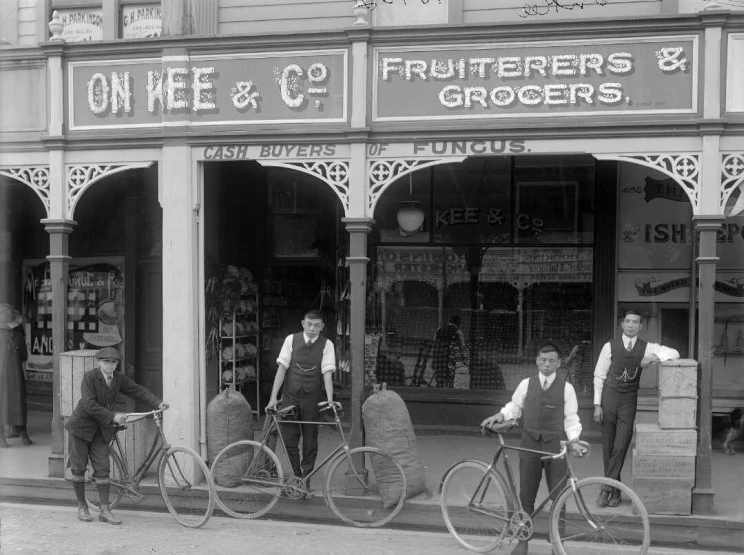
Shows the store front of On Kee & Co, with the display sign 'Fruiterers & Grocers' and 'Cash buyers for fungus'. Three men holding bicycles are standing outside the store while another man, possibly Chan Sheen Chong from Manaia (brother in law of Wong On Kee),with legs crossed and one arm leaning on boxes, stands behind. Photograph taken by James McAllister ca 1910. Ref: 1/1-007957-G. Alexander Turnbull Library.
Literature, historical fiction and poetry
More literary works are being published by Chinese New Zealanders every year. Some examples of the books we hold are below.
As the earth turns silver: a novel / Alison Wong.
Chinese — New Zealand — History — Fiction. Auckland, New Zealand: Penguin Books. 2012.A thin slice of heaven / Paul Wah. Other Title: Cover title in Chinese script: 天堂薄片.; Cover title: Thin slice of heaven = Tiāntáng bópiàn.
New Zealand fiction — 21st century; Historical fiction. Lower Hutt: Paul Wah. 2018.How to be dead in a year of snakes / Chris Tse.
New Zealand poetry — 21st century. Auckland, New Zealand: Auckland University Press. e: 2014.He's so MASC / Chris Tse.
New Zealand poetry — 21st century. Auckland, New Zealand: Auckland University Press. 2018.Chinatown Girl: the diary of Silvey Chan, Auckland, 1942 / written by Eva Wong Ng.
My story (Auckland, N.Z.). Auckland, N.Z.: Scholastic. 2005.
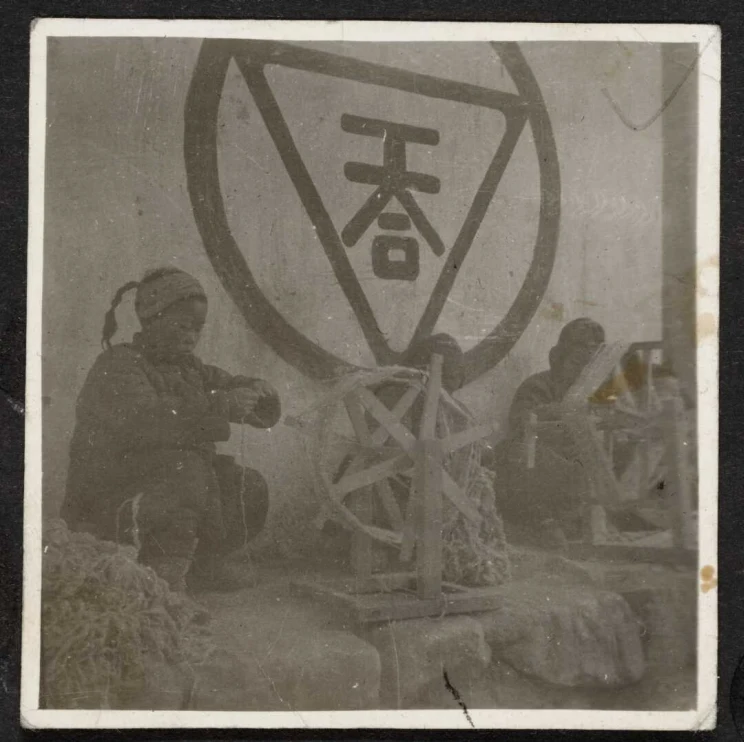
Spinning thread on spinning wheels, China, photographed by an unknown photographer in the 1940s. Ref: PA1-o-899-04-3. Alexander Turnbull Library.
Prominent New Zealanders who spent time in China — Rewi Alley, Kathleen Hall and Agnes Moncrieff
Information about Rewi Alley, Kathleen Hall and Agnes Moncrieff.
Rewi Alley
Rewi Alley, Rewi, (1897-1987) A well-known New Zealander for his work in China, was a farmer, teacher, social reformer, peace activist, and writer. Born in Canterbury, he attended Christchurch Boys' High School. After World War I, he farmed in Taranaki before visiting China, where he spent the rest of his life. He supported the Chinese revolution and helped organize the industrial cooperative "Gung Ho" (Work together) movement and the Shandan Baillie School for Agriculture. He wrote poems and accounts of his work in China.
The Library acquired his large personal collection. There are also items about him by others. The collections comprise photographs — both digital and physical prints, photograph albums, manuscripts, books, abstracts to articles, articles in digitised New Zealand newspapers, art works, recordings and a music score.
National Library website search — Results items in the Rewi Alley collection
A communist in the family: searching for Rewi Alley / Elspeth Sandys.
Elspeth Sandys author. Dunedin, New Zealand: Otago University Press. 2019.
Other resources and institutions related to Rewi Alley

Rewi Alley with his Chinese family, China, ca. 1983. Ref: PA1-q-655-07-1. Alexander Turnbull Library.
Kathleen Hall
Kathleen Anne Baird Hall (1896-1970) was a nurse, missionary. Daughter of Thomas Hall, the district land registrar in Napier, and Helen Baird Hall (née Macky). She carried out pioneering medical work in 1930s China, mainly in Baoding Prefecture, Bebei Province. She worked with the Canadian surgeon Norman Bethune and organised the smuggling of medical supplies past Japanese occupation forces. A contemporary of Rewi Alley she was known as "Nurse Ho"; her Chinese name was He Mingqing, meaning "Clear, bright, earnest".
Shrewd sanctity: the story of Kathleen Hall, missionary nurse in China, 1896-1970 / Rae McGregor.
Auckland, N.Z.: Polygraphia Ltd. c2006.Kathleen Hall — Dictionary of New Zealand Biography entry on
Kathleen Hall — New Zealand China Friendship Society website
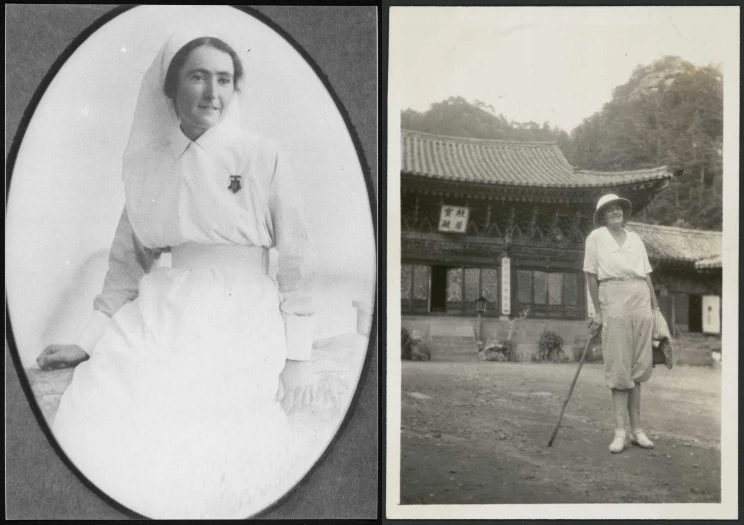
Photograph of Kathleen Hall (1896-1970), missionary and nurse in China, ca. 1930. Ref: 1/2-181983-F. Agnes Moncrieff in the temple court, Hyokunji, China, ca. 1930. Ref: PA1-o-1191-29-3. Alexander Turnbull Library.
Agnes Moncrieff
Agnes Meikle Moncrieff (1898-1988) born in Carterton, the daughter of James Moncrieff. Teacher at Fitzherbert Terrace School (1917-1920) and Feilding Agricultural High School (1925). She was a travelling secretary (1922) and vice chairman for the New Zealand Student Christian Movement. She worked for YWCA from 1929 to 1946, with the majority of this time (1930-1945) spent in China. She later worked as an assistant teacher with the Correspondence School in Wellington.
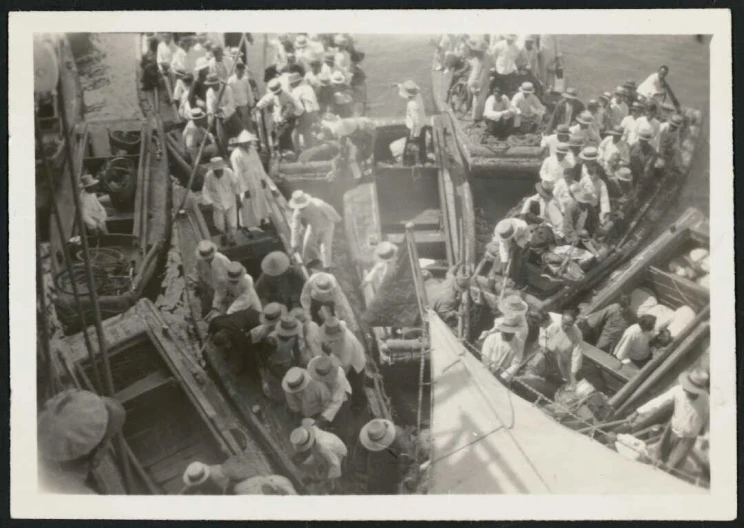
Boats full of people at Weihaiwei, Shandong Province, northern China. Probably photographed by Agnes Moncrieff some time in the 1930s. Ref: PA1-o-1191-30-4. Alexander Turnbull Library.
The Chee Kung Tong (Chinese Masonic Society) / Doris Chung Collection
The Chee Kung Tong (Society for promoting public good) was a secret Masonic society with early roots in China. It began in New Zealand in 1907, had branches throughout New Zealand and was one of the Chinese communities’ lead organisations.
This collection was donated to the Alexander Turnbull Library by Doris Chung (1917-2017). It includes banners and flags, printing blocks; divining sticks, boxed candles, ink grinder, and uniforms worn by members of the orchestra. Also stringed and wooden musical instruments, and percussion instruments.
There are also some photographs and some items have been digitised. Access to physical items is through an appointment with the Curator of Drawings, Paintings and Prints.
National Library website search — Results for collection items related to Chee Kung Tong
National Library website search — Results for collection items related to Doris Chung
Chee Kung Tong; the Hung League in New Zealand (1991). Further information about the Chee Kung Tong and this collection can be found in this publication that accompanied a National Library exhibition on the CKT.
The New Zealand Chee Kung Tong, 1907-1975: sworn brotherhood or political society? / Man-ying Ip. Contributor: NZASIA Conference (1991: University of Waikato). Auckland, N.Z.: Man-ying Ip. 1991. Paper presented to the NZASIA Conference held at University of Waikato, 23-26 August, 1991.

Wellington Chee Kung Tong orchestra, taken ca 1925 at Hardie Shaw Studios, Willis Street, Wellington. Ref: 1/2-169302-F. Alexander Turnbull Library.
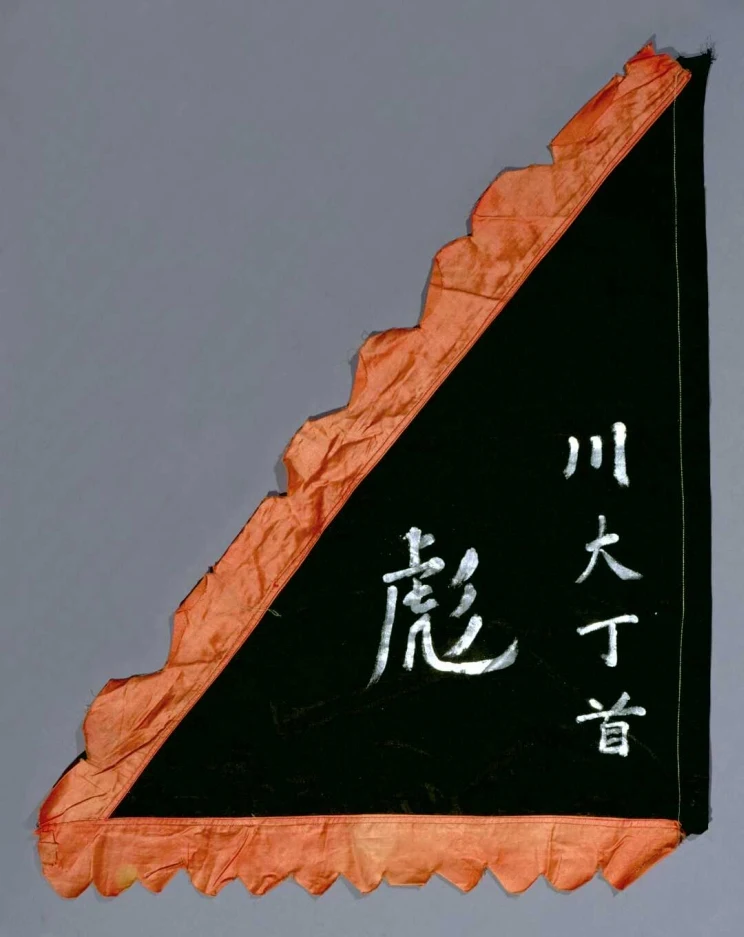
Flag of the 1st Lodge, Hung League. . Ref: D-014-022. Alexander Turnbull Library.
Related content
Help
Where do I start? What do I look for first? Am I even in the right place? Starting your research is always a bit confusing, but we can help out. Have a look at the tips on this page for how to start your research using our website.Research with our digital content from home
This guide will help you start using digital content from the National Library and Alexander Turnbull Library from home.Feature image at top of page: Flag of the 1st Lodge, Hung League. [ca 1925-1946]. Ref: D-014-022. Alexander Turnbull Library.